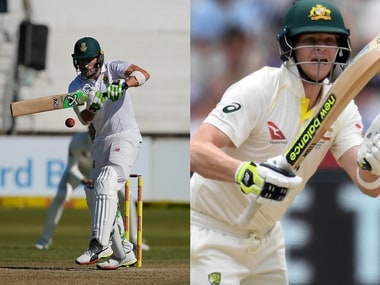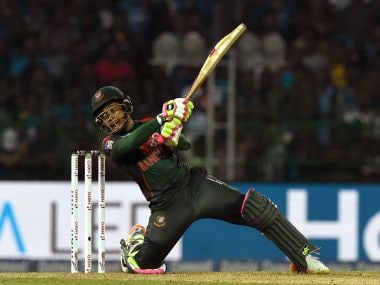India Women vs Australia Women: Mithali Raj-led hosts hope to continue fine form in series-opener
The matches will also see the new playing conditions being used for the first time in India, with two new balls having been introduced, as in men’s cricket.
Snehal Pradhan, March 11, 2018
- ICC Cricket World Cup Qualifiers, 2018 AFG Vs NEP Afghanistan beat Nepal by 6 wickets
- ICC Cricket World Cup Qualifiers, 2018 ZIM Vs HK Zimbabwe beat Hong Kong by 89 runs
- ICC Cricket World Cup Qualifiers, 2018 PNG Vs NED Netherlands beat Papua New Guinea by 57 runs
- ICC Cricket World Cup Qualifiers, 2018 WI Vs IRE West Indies beat Ireland by 52 runs
- England in New Zealand, 5 ODI Series, 2018 NZ Vs ENG England beat New Zealand by 7 wickets
| Rank | Team | Points | Rating |
|---|---|---|---|
| 1 | India | 5313 | 121 |
| 2 | South Africa | 4484 | 115 |
| 3 | Australia | 4174 | 104 |
| 4 | New Zealand | 3489 | 100 |
| 5 | England | 4829 | 99 |
| 6 | Sri Lanka | 4374 | 95 |
| Rank | Team | Points | Rating |
|---|---|---|---|
| 1 | India | 7594 | 122 |
| 2 | South Africa | 6911 | 117 |
| 3 | England | 7102 | 116 |
| 4 | New Zealand | 6782 | 115 |
| 5 | Australia | 6376 | 112 |
| 6 | Pakistan | 4877 | 96 |
| Rank | Team | Points | Rating |
|---|---|---|---|
| 1 | Pakistan | 3272 | 126 |
| 2 | Australia | 2513 | 126 |
| 3 | India | 3940 | 119 |
| 4 | New Zealand | 3013 | 116 |
| 5 | West Indies | 2538 | 115 |
| 6 | England | 2402 | 114 |





You can take an Australian out of Australia but you can’t take the banter out of the Australian. I’m not talking about the Durban Test match, but recalling a conversation from last year.
Before the semifinal of the 2017 Women’s World Cup, as we waited for the clouds to pass, some banter rained in the press box. An Australian colleague asked me, with a certain amount of smug certainty, ‘So, do you think India can beat Australia?’ When the two teams had met in the league stage, India were completely outplayed. Their total of 226, built on a first-ever century against Australia in World Cups by Punam Raut, was deconstructed like a jigsaw in reverse. Australia won by eight wickets with five overs to spare, putting the overall head-to-head record at 34-8 in their favour.
File image of India captain Mithali Raj . AP
Undeterred, I replied, ‘Can, yes. Will?’, I shrugged my shoulders. It needed something special to beat Australia, and I sincerely believed the Indian team had what it takes. But finding that ‘special something’ could be harder than summoning a broomstick with a fire-breathing Hungarian Horntail standing in front of you.
Like in the Goblet of Fire however, India got it right, almost magically so. It was a different Harry who provided the spell; Harmanpreet Kaur’s unbeaten 171 off 115 balls taking India to victory and a World Cup final.
Six months later, the same question stands though. Can India beat Australia? England may be world champions. India may be the World Cup finalists. But Australia are still the best team in the world, and they are keen to prove it.
To that end, they have made four changes to their side that played the Ashes, and the biggest is the change in leadership. Rachael Haynes will relinquish captaincy as Meg Lanning returns from shoulder surgery. Lanning and Haynes are the only players in this team to have played 10 One-Day Internationals (ODIs) in India. No 4 Ellyse Perry has only four ODI innings on Indian soil, so few in this batting lineup have experience of constructing innings in these conditions. Aussie coach Matthew Mott pointed out that Lanning’s experience is a welcome return, having lost their most capped player with the retirement of Alex Blackwell.
“I suppose it makes up a little bit for the loss of Alex”, said Mott upon arrival in India. “One experienced player coming in, one going out. Meg’s really champing at the bit, almost like the youthfulness of a debut.” A hungry Lanning is dangerous for India. At just 25, her numbers are already legendary, with more ODI hundreds (11) than anyone else. She also averages 41 in India.
If Australia will be buoyed by their captain’s return, India come into this series on the crest of their most successful away tour, having won both ODI and T20I series in South Africa. The batting roared on South African pitches, with four Indians in the top six scorers there. The batting will again need to outperform, especially as the bowling is missing its spearhead, with Jhulan Goswami yet to recover from a bruised heel. This means that 18-year-old Pooja Vastrakar is likely to continue sharing the new ball with Shikha Pandey.
Fittingly, this incendiary series will be played in a petrochemical factory, at the Reliance Stadium. This could negate the Indian spinners; the ground has a reputation as a flat batting track, with the last first-class match here seeing a 900-run draw. But with Baroda being the home of Indian coach Tushar Arothe, it will be interesting to see if the pitches are a bit more bespoke.
The matches will also see the new playing conditions being used for the first time in India, with two new balls having been introduced, as in men’s cricket. At the same time, the batting powerplay, phased out of the men’s game, has been retained in women’s cricket, in a bid to make matches more high-scoring. The rules also allow only four fielders outside the 25 yard circle in non-powerplay overs. Alongside the shortened boundaries, and the power game that both teams are capable of, a lot of runs are expected in Baroda this week, something the broadcasters won’t complain about, but the bowlers might.
Last year, captain Mithali Raj asked her team to find one level higher if they wanted to beat the Australians. India duly did so, pulling out a wild card in the semifinal. But the more times you draw, the shorter the odds are of finding that card again and again. India need to discover a more reliable, more easily summon-able formula to win a three-match series. The game is on the rise in the country, with television coverage as well as posters around Baroda broadcasting the matches. But this week will show where the Indians really stand on the global ladder. There is more than just ICC Women’s Championship points at stake.
The author is a former India cricketer, and now a freelance journalist and broadcaster. She hosts the YouTube Channel, ‘Cricket With Snehal’, and tweets @SnehalPradhan
Published Date:March 11, 2018
| Updated Date: March 11, 2018